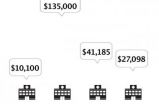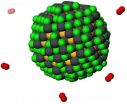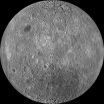(Press-News.org) AURORA, Colo. (June 9, 2014) – In an article published in the scientific journal Nature, a University of Colorado School of Medicine researcher and colleagues explain how RNA molecules found in certain viruses mimic the shape of other molecules as part of a strategy to 'hijack' the cell and make more viruses.
The findings by Jeffrey S. Kieft, PhD, associate professor of biochemistry and molecular genetics at the School of Medicine and an early career scientist with the Howard Hughes Medical Institute, and his colleagues solve a biochemical and molecular mystery that has confounded scientists for decades.
Viruses are worldwide threats to health and agriculture. To multiply, viruses infect a cell and take over that cell's biochemical machinery. Thus, understanding the fundamental molecular processes used by viruses to conquer cells is important. Among these processes is the ability of molecules created by viruses to 'mimic' the structure and behavior of cellular molecules. The virus' molecular 'Trojan horses' are part of their strategy to take over cells.
The paper describes the three-dimensional structure of a viral RNA that mimics one of the most abundant RNAs found in the cell. It was known for many years that this viral RNA was a molecular mimic. However, how the RNA acts as a mimic, how it switches between different structures, and how it performs multiple tasks was a mystery.
Using a technique called x-ray crystallography, Kieft and colleagues visualized the molecule's complex three-dimensional structure to high resolution. They found that the viral RNA has a 'two-faced' architecture: one face is a mimic of the cell's RNA, the other face is less similar and this probably gives the ability to perform several tasks during infection. This type of behavior may be widespread, thus this research could apply to many different viruses.
This understanding of how a viral RNA can mimic other molecules as part of a strategy to 'hijack' a cell may help scientists develop treatments or vaccines against infectious diseases.
INFORMATION:
Kieft is the corresponding author of the article, "The structural basis of transfer RNA mimcry and conformational plasticity by a viral RNA," published online on June 8 by Nature. The other authors are Timothy M. Colussi, PhD, David A. Costantino, MS, John A. Hammond, PhD, Grant M. Ruehle, and Jay C. Nix, PhD. Funding was provided by the Howard Hughes Medical Institute and the National Institutes of Health.
Faculty at the University of Colorado School of Medicine work to advance science and improve care. These faculty members include physicians, educators and scientists at University of Colorado Hospital, Children's Hospital Colorado, Denver Health, National Jewish Health, and the Denver Veterans Affairs Medical Center. The school is located on the Anschutz Medical Campus, one of four campuses in the University of Colorado system. To learn more about the medical school's care, education, research and community engagement, visit its web site.
CU researchers explain mechanism that helps viruses spread
2014-06-09
ELSE PRESS RELEASES FROM THIS DATE:
Satellite sees System 90L dissipating over Mexico
2014-06-09
NASA and NOAA satellites are gathering visible, infrared, microwave and radar data on a persistent tropical low pressure area in the southwestern Bay of Campeche. System 90L now has a 50 percent chance for development, according to the National Hurricane Center and continues to drop large amounts of rainfall over southeastern Mexico.
The Atmospheric Infrared Sounder (AIRS) instrument aboard NASA's Aqua satellite gathered infrared data on the developing low on June 5 at 18:59 UTC (2:59 p.m. EDT).
Basically, AIRS looks at the infrared region of the spectrum. In a spectrum, ...
Scientists may have identified echoes of ancient Earth
2014-06-09
A group of scientists believe that a previously unexplained isotopic ratio from deep within the Earth may be a signal from material from the time before the Earth collided with another planet-sized body, leading to the creation of the Moon. This may represent the echoes of the ancient Earth, which existed prior to the proposed collision 4.5 billion years ago. This work is being presented at the Goldschmidt conference in Sacramento, California.
The currently favoured theory says that the Moon was formed 4.5 billion years ago, when the Earth collided with a Mars-sized mass, ...
Surgery prices are elusive
2014-06-09
Let's say you're buying a car. You have a wealth of data at your fingertips, from safety information to performance, to guide your decision.
The same is not as true in health care, especially if you're pricing procedures. A new study from the University of Iowa compared the cost of prostate cancer surgery at 100 hospitals throughout the United States. The quote for the procedure, the researchers found, varied from $10,100 to $135,000, a 13-fold range. (The average price was nearly $35,000, more than double the Medicare reimbursement.)
Only 10 of the hospitals that provided ...
New class of nanoparticle brings cheaper, lighter solar cells outdoors
2014-06-09
TORONTO, ON — Think those flat, glassy solar panels on your neighbour's roof are the pinnacle of solar technology? Think again.
Researchers in the University of Toronto's Edward S. Rogers Sr. Department of Electrical & Computer Engineering have designed and tested a new class of solar-sensitive nanoparticle that outshines the current state of the art employing this new class of technology.
This new form of solid, stable light-sensitive nanoparticles, called colloidal quantum dots, could lead to cheaper and more flexible solar cells, as well as better gas sensors, infrared ...
With distance comes greater wisdom, research finds
2014-06-09
If you're faced with a troubling personal dilemma, such as a cheating spouse, you are more likely to think wisely about it if you consider it as an observer would, says a study led by a professor at the University of Waterloo.
Professor Igor Grossmann, of Waterloo, and Professor Ethan Kross from the University of Michigan, asked study participants to reflect on a relationship conflict of their own or someone else's, such as a spouse's infidelity with a close friend, and think about the conflict in the first and third person. The findings will appear in an upcoming issue ...
Online marketing schemes can still lure in customers
2014-06-09
Despite warnings and legislation, online consumers may still be susceptible to post-transaction marketing schemes, according to Penn State researchers.
At least 40 percent of consumers who made an online purchase in a study bought an additional product, even though it offered no extra value, said Jens Grossklags, assistant professor of information sciences and technology.
"The focus of this study was to determine the likelihood that a consumer would accept an offer after they had already made a purchase," said Grossklags. "What stood out was the vast number of people ...
Seeing how a lithium-ion battery works
2014-06-09
CAMBRIDGE, Mass-- New observations by researchers at MIT have revealed the inner workings of a type of electrode widely used in lithium-ion batteries. The new findings explain the unexpectedly high power and long cycle life of such batteries, the researchers say.
The findings appear in a paper in the journal Nano Letters co-authored by MIT postdoc Jun Jie Niu, research scientist Akihiro Kushima, professors Yet-Ming Chiang and Ju Li, and three others.
The electrode material studied, lithium iron phosphate (LiFePO4), is considered an especially promising material for ...
Science and technology advances in microbial forensics needed to better prepare
2014-06-09
WASHINGTON – Much as human DNA can be used as evidence in criminal trials, genetic information about microorganisms can be analyzed to identify pathogens or other biological agents in the event of a suspicious disease outbreak. The tools and methods used to investigate such outbreaks belong to an emerging discipline known as microbial forensics, but the field faces substantial scientific and technical challenges, says a new report from the National Research Council. The report offers an initial set of research priorities for advancing the capabilities needed to make microbial ...
Specific protein may help beta cells survive in type 1 diabetes
2014-06-09
In the healthy pancreas of someone without type 1 diabetes (T1D), the hormone insulin (essential for turning food into energy) is produced, stored, and released in a normal "factory-like" process within pancreatic beta cells in response to glucose in the diet. Early in the course of T1D, however, excessive or pathologic stress in beta cells compromises their ability to properly secrete insulin, triggering a cascade of events ultimately contributing to the beta cell death. Over the past several years, JDRF-funded researchers have found evidence that beta cell stress may ...
55-year old dark side of the moon mystery solved
2014-06-09
The Man in the Moon appeared when meteoroids struck the Earth-facing side of the moon creating large flat seas of basalt that we see as dark areas called maria. But no "face" exists on farside of the moon and now, Penn State astrophysicists think they know why.
"I remember the first time I saw a globe of the moon as a boy, being struck by how different the farside looks," said Jason Wright, assistant professor of astrophysics. "It was all mountains and craters. Where were the maria? It turns out it's been a mystery since the fifties."
This mystery is called the Lunar ...



